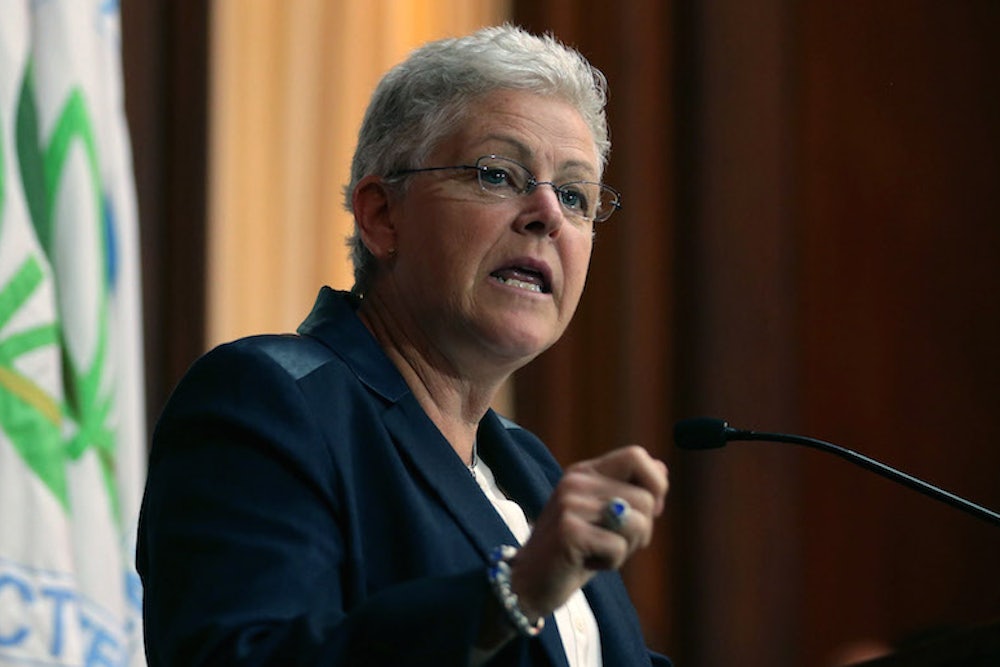The Obama Administration's plan for cutting carbon emissions from power plants is now public. The initial reaction, from both sides of the climate debate, is that it's the big deal they had been expecting.
Under the new plan, each state will have responsibility for reducing the amount of carbon dioxide that its power plants produce—and each state will have flexibility over exactly how to meet those goals. State officials can require that utilities make existing plants more efficient, for example, or they can create incentives for consumers to use less energy. Officials will also have the option to create systems of tradable pollution permits, within their own borders or across state lines as part of regional “cap-and-trade” markets.
The Environmental Protection Agency is setting a different reduction for each state, based on a formula that takes into account factors like natural resources and progress that states have already made towards reducing emissions. If state officials don't submit plans that hit those targets—or if they fail to submit plans at all—then the EPA will impose standards upon them.
The state-based, market-friendly approach to climate change that the EPA has endorsed would seem to be the kind of plan that at least some conservatives would support—particularly since, not that long ago, similar proposals had some prominent Republican advocates. Nobody expects that to happen. The Republican National Committee is already warning that “the American economy will pay the price” because of Obama’s “war on coal.”
As a result of the proposal, Administration officials say, carbon output in 2030 would be at least 30 percent lower than it was in 2005 levels. That goal, first reported on Sunday by Amy Harder of the Wall Street Journal, is not as ambitious as the one that most environmental groups had proposed. It means that the U.S. will likely have to take additional action, such as reducing methane emissions from pipelines and landfills, if it hopes to reduce greenhouse gas production by as much as President Obama pledged in 2009. But the Administration is already at work on those additional measures, as part of the Climate Action Plan that Obama unveiled a year ago. "I don't think this one proposal ... should be viewed as the entire means to achieve the Copenhagen targets," says Jennifer Macedonia, senior advisor on climate issues at the Bipartisan Policy Center.
That may help explain the reaction from prominent environmental advocates—the Environmental Defense Fund, the Natural Resources Defense Council, the Sierra Club, and even Bill McKibben’s 350.org, have put out strongly positive statements. These groups will nudge the Administration to make the regulations even stronger, since it doesn't become final for another year. But—to answer a question several people, including yours truly, raised over the weekend—they still see the proposal as a watershed moment. After all, they say, this is the first time the U.S. is regulating existing power plants for the sole purpose of reducing greenhouse gas emissions. That sends a powerful signal about priorities, they say—to the rest of the country and to the world, as well.
Plus it will mean a decline in global warming and the dire consequences that come with it.
It's going to take a few days for experts and lawyers to go over the proposal, which is several hundred pages long. By the time they are done, you can bet they will have will discovered features—good, bad, and in between—that nobody has grasped yet. But whatever these policy sleuths find, there's going to be a major debate over the proposal's economic impact. “A 30 percent reduction—even from a 2005 baseline—will be very costly and have a substantial impact on the cost of electricity in most parts of the country,” says Jeff Holmstead, a former EPA official and climate attorney from Bracewell and Guiliani who advises energy companies. A study that the U.S. Chamber of Commerce released last week made similar predictions.
But the Chamber’s study included all kinds of shaky assumptions and its prediction of higher electricity prices was not actually that big. As Jonathan Chait observed in New York magazine, “Even the Chamber’s unrealistically dire number is still low enough that most people would barely notice it.” Meanwhile, studies from environmental groups have suggested that, if anything, the power plant plan will save the country money—particularly if you consider the cost of dealing with the effects of climate change.
Note: This item has been updated.
